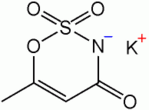High-intensity sweetener blends enhance frozen dairy formulations
High-intensity sweeteners provide today's health-conscious consumers with an opportunity to enjoy good-tasting, lower calorie or no-sugar-added frozen desserts such as ice cream and frozen yogurt.
In 1995, Sunett[R] brand sweetener (acesulfame potassium [K]), a high-intensity sweetener, was approved for application in dairy foods such as yogurt and yogurt-type products, as well as refrigerated and frozen desserts such as gelatin, ice cream and novelties.
Acesulfame K is non-caloric. It's stable during typical food processing temperatures and across a broad pH range. It also has excellent water solubility (27g/100g, at room temperature). High solubility makes food processing go fast and trouble free (i.e. no clump formation and no filter clogging).
Acesulfame K can partially substitute for sucrose in lower calorie and no-sugar-added ice cream and frozen yogurt formulations. Due to its intense sweetness, it can be used in rather small quantities. It contributes to overall desired sweetness but does not supply bulk or contribute to textural characteristics. Therefore, acesulfame K is regarded as a sweet-tasting or sweet-flavoring compound.
Because acesulfame K doesn't supply bulk, bulking agents are necessary in the formulation of lower calorie products. Sugar alcohols such as disaccharide alcohols (lactitol, maltitol and isomalt) and monosaccharide alcohols (sorbitol) can be used to provide bulk and improve texture. These sugar alcohols also provide some sweetness (40-90% sweetness relative to sucrose). Acesulfame K complements the taste characteristics of sugar alcohols and rounds out the sweetness profile.
Another bulking agent, polydextrose, has no sweetness. Polyols, in conjunction with polydextrose and high-intensity sweeteners, can successfully be used in the production of lower calorie or no-sugar-added frozen desserts.
Application guidelines
In formulations, acesulfame K contributes a rapidly perceived sweet taste with no lingering aftertaste. Blends of acesulfame K with other high-intensity sweeteners, as well as nutritive sweeteners, result in a well-balanced, immediate sweetness with no unpleasant aftertaste. Blends have also been shown to taste more like sucrose.
Hoechst Food Ingredients, suppliers of Sunett brand acesulfame K, conducted a consumer study on blends of acesulfame K and aspartame versus aspartame-only sweetened yogurts. The sweetener blend received higher acceptability ratings and was preferred over aspartame-only sweetened yogurt.
"This taste improvement is termed qualitative synergy," says Zari Nakhost, principal food scientist with Hoechst. "Single high-intensity sweeteners are not able to duplicate the exact taste of sucrose. The ability to improve the sweetness quality of the individual sweeteners by sweetener blends that include Sunett brand sweetener is called the Sunett Multi-Sweetener Concept."
In addition to taste enhancement, blending acesulfame K with other sweeteners also results in reduction of total sweetener used in the formulation.
"This is described as quantitative synergy," she adds. "This means that when blending acesulfame K with other sweeteners a greater sweetness intensity than would be expected is obtained."
This marked intensification of sweetness is observed with blends of acesulfame K and most other high-intensity sweeteners, and to a slightly lesser extent with sucrose and high-fructose corn syrup. Up to a 40% increase in sweetness intensity can be achieved as a result of blending acesulfame K with aspartame. For example, a blend of 150 ppm acesulfame K and 150 ppm aspartame is equal to 9.0% sucrose, whereas 300 ppm of either sweetener is equal to only 5.0% sucrose. Consequently, quantitative synergy translates into ingredient cost savings, which is attractive to food manufacturers.
COPYRIGHT 1997 Business News Publishing Co.
COPYRIGHT 2004 Gale Group



